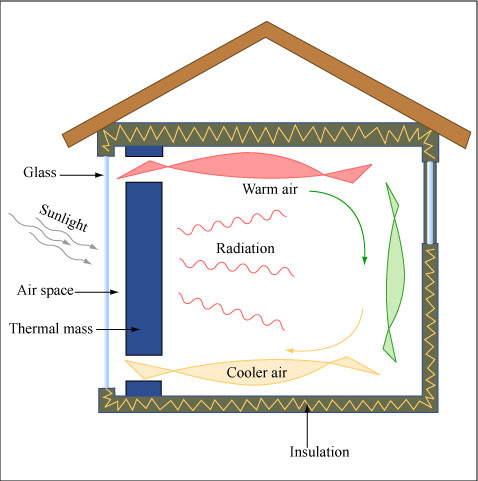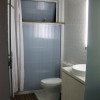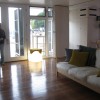Maximizing the Sun's Heat
Video
alt=""According to Architecture 2030, the key to preventing the impending loss of our polar ice caps (as written in my recent blog post) is to reduce our use of coal, which is used to generate electricity. Mazria, the founder of Architecture 2030, recommends we reduce our use of coal first by using passive solar solutions, and then by supplementing those solutions with active eco-friendly technologies to get us to cut emissions that ultimately lead to the melting of Earth's polar ice caps.
The Knowlton School of Architecture (KSA) and The College of Engineering at The Ohio State University partnered to compete in the 2009 National Renewable Energy Lab's Solar Decathlon Competition that was held in October at the Oval in Washington D.C. The team of OSU architecture and engineering students, led by David Nedrow and Deanna Hinkle, who both were graduate students in the Masters of Architecture program at OSU, presented a compelling design that functions off-the-grid (the home generates its own electricity and does not depend on traditional public utility services) with both passive solar design and active solar technologies.

Passive Solar
Passive solar techniques date back to ancient Greece, yet modern societies have largely neglected to implement them in our contemporary architectural designs: ďNow in houses with a south aspect, the sunís rays penetrate into the porticoes in winter, but in summer the path of the sun is right over our heads and above the roof, so that there is shade. If, then, this is the best arrangement, we should build the south side loftier to get the winter sun and the north side lower ...to keep out the cold winds.Ē Socrates, as quoted by Xenophon in Memorabilia.
Passive solar designs do not cost the homeowner any additional money, but they are dependent upon extra planning and careful scientific calculations. In the northern hemisphere, designers create passive solar buildings with the south facade constructed largely of glass. In the winter, the sun passes through the glazing and heats up materials (thermally massed walls and flooring) within the building during the day. At night, the thermal materials radiate heat. Shading devices and landscaping are added to maximize and minimize the sun at the certain times of the day and season. The east, west, and north sides of the building are largely protected from the sun's exposure.
Radiant Heat & the Trombe Wall
In order for a passive solar building to provide radiant heat during the "heating hours" of the day, a certain amount of thermal mass must be designed into the home. One of the many ways to add thermal massing to a building is to install a trombe wall. Originally invented by Edward Morse in 1881, it was the French engineer Felix Trombe who further developed the invention in the 1960's and caused it to become recognized world-wide.
The trombe wall is a thermal mass comprised of a densely conductive material, such as concrete or masonry, with a vented air-space in between the massing wall and the exterior glass facade. The sunís infrared rays penetrate through the glass, store heat in the mass of the wall, and then the heat is radiated into the living space during the evening and night hours. In addition to radiant heating, vents at the base of the wall draw in cold interior air that warms as it moves up past the heated wall and re-enters the room from the vent at the top via convection. The vents can later be modified to route built-up heat to the exterior of the building in the summer months.
How Does a Trombe Wall Function?
 The trombe wall must be located on the south side of the building with an unobstructed view to the sunís exposure during the day, and the foundation must be properly insulated to prevent heat loss into the ground. The glass can be decorative and even colored to add to the faÁadeís design and to the lighting effect on the inside. A special type of insulation made from aerogel can be installed between the glass and the wall to insulate against radiation of the winterís nightime cold through the glass. Aerogel insulation allows for over 90 percent of the sunís light to transfer through the material to heat the mass wall beyond.
The trombe wall must be located on the south side of the building with an unobstructed view to the sunís exposure during the day, and the foundation must be properly insulated to prevent heat loss into the ground. The glass can be decorative and even colored to add to the faÁadeís design and to the lighting effect on the inside. A special type of insulation made from aerogel can be installed between the glass and the wall to insulate against radiation of the winterís nightime cold through the glass. Aerogel insulation allows for over 90 percent of the sunís light to transfer through the material to heat the mass wall beyond.
As passive solar techniques such as the trombe wall become more popular, we as a population will become more sophisticated with these technologies, understanding how to correctly implement them so as to capitalize upon their effectiveness. For heating solutions, there are generally three strategies that utilize solar radiation: direct gain, indirect gain and isolated gain. The trombe wall is an indirect gain technology that can be constructed with greater heat radiation benefits using water as opposed to the more common materials of concrete and masonry.
In contrast to direct gain passive solar strategies, a handful of the advantages of the trombe wall are that it blocks ultraviolet rays from fading furniture, it allows the sunís radiation to be ďstoredĒ in the wallís mass, and it prevents the living spaces beyond from overheating on sunny days. Though visual access is lost through the window employed by the complex wall-layering system, additional windows can be introduced into the space to allow for desirable, unobstructed views.
A Trombe Wall Variation at OSU's Solar Decathlon House 1
 Due to project constraints, the Solar Decathlon Team came up with an innovative new trombe wall design. With only 540 sf of living space, the team had no choice but to design a trombe wall that was neither bulky in size nor opaque. The trombe wall is composed of two layers of a polycarbonate material called ThermoGal with 36 total water-filled acrylic tubes sandwiched inside the system. "Engineering students are currently calculating the exact benefits of our house, in particular the trombe wall. We know that it worked, though, because we could feel the heat dissipating warmth to the touch at night," says David Nedrow, one of the KSA Masters of Architecture graduates who was instrumental in the design and construction of the project.
Due to project constraints, the Solar Decathlon Team came up with an innovative new trombe wall design. With only 540 sf of living space, the team had no choice but to design a trombe wall that was neither bulky in size nor opaque. The trombe wall is composed of two layers of a polycarbonate material called ThermoGal with 36 total water-filled acrylic tubes sandwiched inside the system. "Engineering students are currently calculating the exact benefits of our house, in particular the trombe wall. We know that it worked, though, because we could feel the heat dissipating warmth to the touch at night," says David Nedrow, one of the KSA Masters of Architecture graduates who was instrumental in the design and construction of the project.
In the case of the Solar Decathlon House 1, the water is the thermal material that is heated by the sun. Furthermore, the ThermoGal has an R-value (insulation factor) higher than that of any known glass material. Not only is the trombe wall system thin, "The frosted material diffuses light without losing any visibility. There are private spaces behind that wall; a bathroom and a bedroom. We are still able to get light into those spaces without worrying about privacy," says Nedrow.
Other passive solar techniques at the Solar Decathlon House 1 are natural ventilation and a louver system that is used to control the amount of UV rays entering the home during different seasons. "We wanted to add skylights as well, but found out that they would cause constructability problems with adding too many penetrations into the roofing membrane. We also found that they would emit too great a heat loss for the design's efficiency," says Nedrow.
As for the active solar technologies, a 5kW photovoltaic array provides enough energy for all the lighting and appliances in the home. A system of solar evacuated tubes heat the domestic water and the water in the radiant floor heating system. The team expected the project to cost $260,000, but the end product was closer to the $180-200,000 range. "The home was designed to be ultimately practical and widely accessible so that it could serve as a model for mass production," says Nedrow.
The home was constructed on The Ohio State University campus, then shipped to be on display at the Oval in Washington D.C. for the competition. In March 2010, the OSU Solar Decathlon House 1 will make its final landing in a poetic location for the next two years - near the Polar Bear exhibit at the Columbus Zoo.
See also: Let the Daylight In

Stephanie Aurora Lewis
Stephanie, an NCARB registered architect and LEED AP, draws upon her studies in architectural history and theory from Sarah Lawrence College and her masterís degree in architecture from The Ohio State University. Providing copy for publications and performing marketing work for the construction industry, Stephanie works as an independent freelancer from Columbus, Ohio.
Website: greengaloredesigner.blogspot.com/





